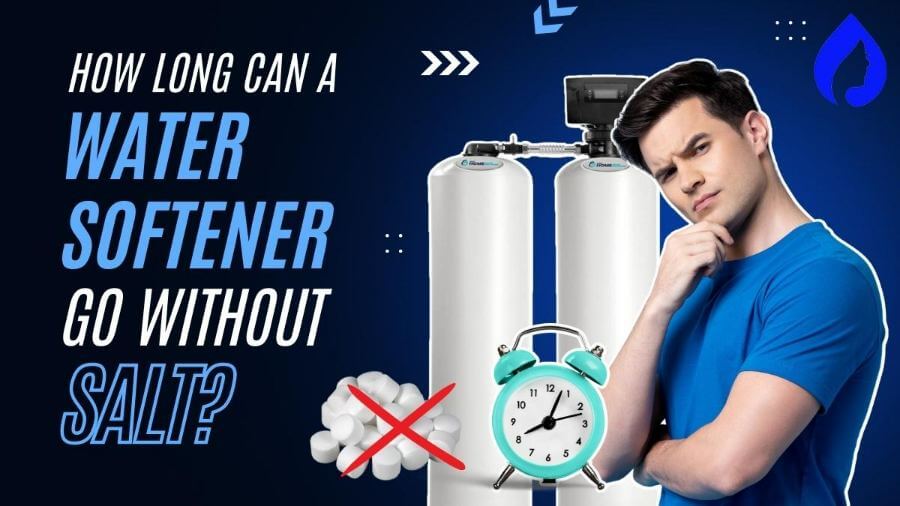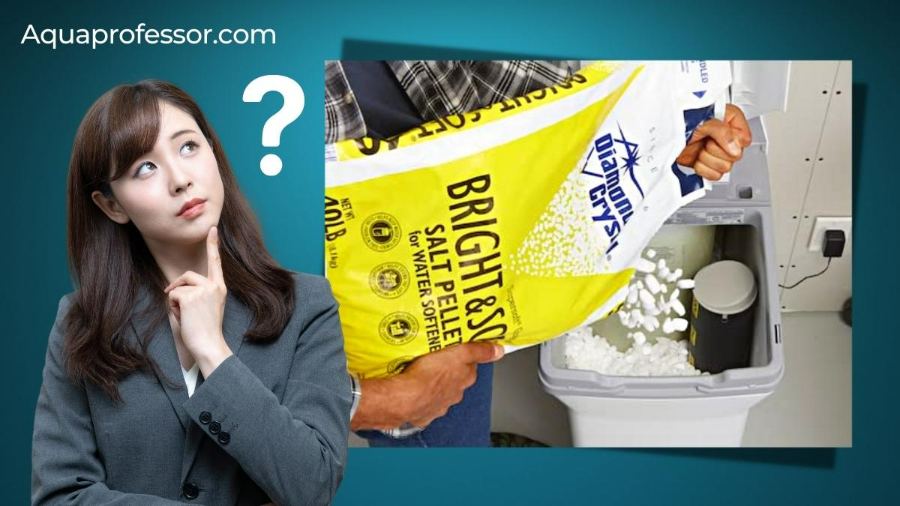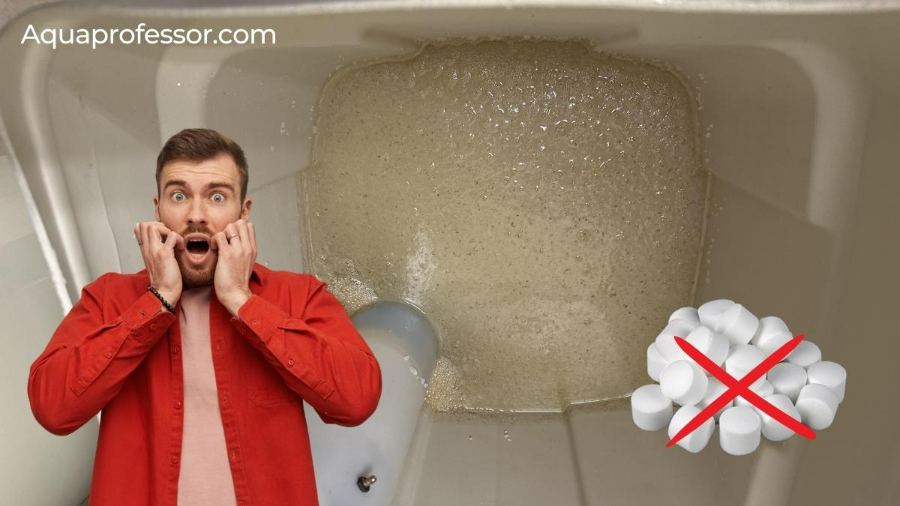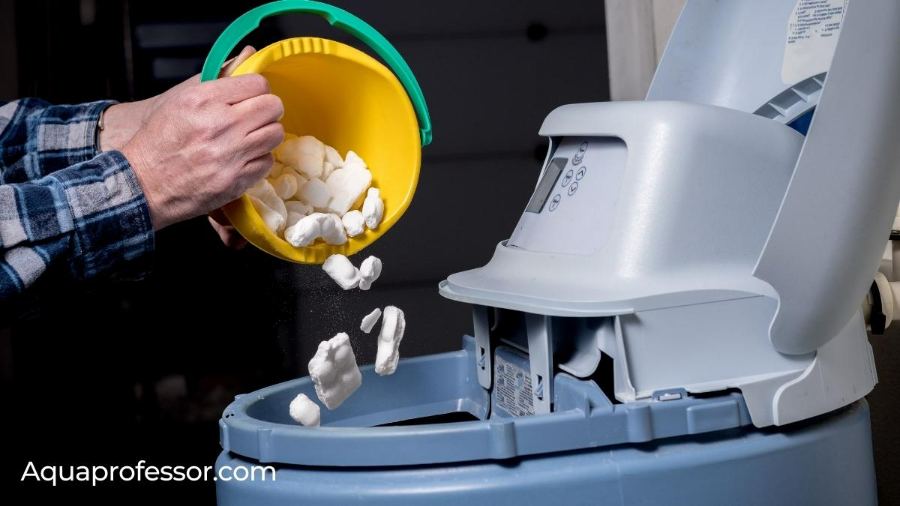
A water softener can work for 8-12 weeks before requiring a salt refill, but it depends on the salt’s quality, incoming water hardness, water softener’s efficiency, and water usage.
It’s always ideal to check your water softener’s salt level once every six weeks to avoid it dropping too low.
Most modern water softeners have low salt indicators for a quick check.
Continue reading for an in-depth guide on softener salt usage.
🤔 How Long Does A 50 Lb Bag Of Salt Last For A Water Softener?

A 50 lb water softener salt bag can last for 5-6 weeks, and a 40lb of the same salt bag can last for a month. However, this depends on factors like:
🥛 Water Hardness
Your tap water’s hardness can determine how quickly salt will be used up.
Hard water contains high levels of calcium and magnesium, which are hard minerals and must be replaced with sodium ions (Na2+) using the salt in the brine tank.
The more the water hardness, the faster the resin bed depletes, thus demanding more salt to make its regular regeneration continue.
🔳 Iron Concentration
Your water’s iron concentration level may also strongly influence the salt required for your water softener or the salt’s changing frequency level.
Here changing refers to adding new salt.
Most salt-based water softeners can remove up to 1 ppm of iron. But higher iron concentrations can overwork the system and require frequent salt refills.
It’s better to install an iron-removal water filter if your incoming water contains more than 1 ppm of iron concentrations to ensure better softener performance and water quality.
🧂 Salt Quality

Evaporated salt is of high quality (containing a higher percentage of pure Na2+ ions), and needs less frequent refilling in the tank than low-quality ones (for example, Rock salt) or medium-quality ones (for example, solar salt).
But it gets worse:
Low-quality salts comprise many impurities that may clog up your water softener’s brine tank, eventually damaging the machine.
🚰 Water Usage
The amount of water you use daily determines how much salt you need to add to your brine tank. It also tells how frequently you must refill your brine tank with salt.
If you’ve invited many guests or didn’t size your softener properly before buying (based on your family size), your water softener will be forced to use more salt in the water-softening resin to exchange hard water ions for sodium ions.
It translates to frequent salt refills. So, you need to add salt frequently within the water softener tank.
🔄 Softener REGEN Frequency
The more your water softener regenerates, the more frequent salt refills it needs. It’s particularly critical in the case of time-based water softeners.
👉 Allow me to explain:
There are two types of water softeners: demand-initiated and time-based.
Demand-initiated water softeners regenerate based on water usage, so REGEN cycles are less (hence less salt demand).
However, time-based water softeners regenerate based on the programming inputs on ECH (Electronic Control Head).
And you already know how good we’re at water usage math 🙄
So in 9/10 times, it’ll regenerate unnecessarily, resulting in:
✌ There are two ways to fix this:
Also Read: Does Water Softener Salt Kill Grass And Weeds?
🧐 What Happens if You Stop Putting Salt in Water Softener?

If your water softener runs out of salt, it won’t give you softened water anymore.
So, you’ll start facing all the hard water problems again (hard water stains, soaps not lather, and limescale buildup).
But there’s more! Running a water softener for a long time without salt can shorten the softener’s lifespan as REGEN cycles are affected, and hard water minerals can damage the piston chamber.
Also, without salt, your softener can’t remove iron in water. So, refilling salt before the brine tank is half empty is best.
Also Read: How Much Salt in Water Softener is Too Much?
🙁 What Should You Do if Your Water Softener Runs Out of Salt?

If your water softener’s brine tank runs out of salt, add more salt to keep the device functioning.
🙄 How Do You Add Salt To An Empty Water Softener?
👩🔧 How To Reset Water Softener After Adding Salt
After you have done with the salt-adding process, wait for 4-6 hours to start regeneration. It’s because salt needs time to dissolve.
📜 Tips to Avoid Empty Brine Tank
🧂 How Long Can A Water Softener Go Without Salt FAQs
🔲 How long can a water softener sit unused?
Your water softener machine can sit still and unused for nearly 1 week. However, it depends on:
1. Your water softener’s type: Ion exchange softeners can sit unused for 30 days, whereas salt-free systems can condition water even after long periods of inactivity.
2. Your softener’s resin quality: If you use 10% cross-linked resin, it’ll be effective even after a longer period of inactivity compared to 8% cross-linked resin.
3. Various environmental conditions: Keeping your softener in excessive heat waves, freezing climates, or excess humidity will ruin the longevity of the resin and its other parts. So better install your water softener in a cool and dry place.
🌀 What to do if the water softener is out of salt and full of water?
If your water softener’s brine tank runs out of salt and becomes full of water, do the following:
1. Find and repair the softener part that’s stopping the brine tank from emptying water and refilling it appropriately.
2. Clean the tank’s inner spaces
3. Clean up the resin
If the above steps fail to solve your problem, drain the tank and start everything again from the beginning. Here’s how:
1. Throw out all the water inside.
2. Scoop out both the salt and the water within a bucket. Take the help of a wet-dry vacuum.
3. Go for a manual regeneration cycle.
🤔 How do I know if my softener needs salt?
To determine whether your softener lacks salt or not, you need to –
1. Lift your brine tank’s cover and see the salt level within it.
2. If your salt appears dry and the brine tank’s salt level lowers than half full, pour more salt until it is half-full.
3. If you see the salt wet or water level higher than the salt level, know that you need to fill up the tank to half full.
🔄 Do I need to regenerate my water softener when I add salt?
Yes, whenever you add salt to your water softener, it is a must to regenerate your water softener for about 4-6 hours by doing the following:
1. Press and hold the device’s “recharge” button for 3 secs and reset the machine’s salt level indicator.
2. The “recharge” button enables the brine solution to travel within the softener machine and then get released.
Note:- You can reset the water hardness level of a water softener anytime you want.
🧂 What happens if you add too much salt to a water softener?
Adding excessive salt to your water softener can cause salt bridging, which is salt’s solid buildup inside the brine tank. It may slow the normal regeneration process of your softener.
Sayan understands that access to clean water doesn’t have to be costly.
He strives to provide knowledge of water purification techniques in the simplest way possible so that we can lead a healthy life without breaking our bank.
